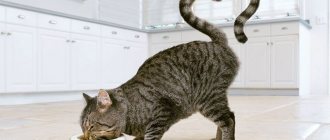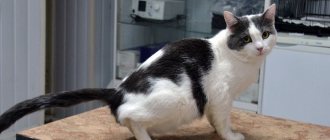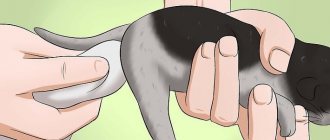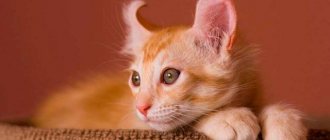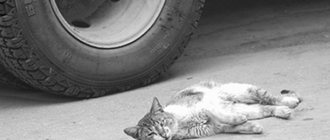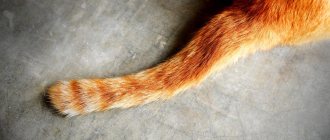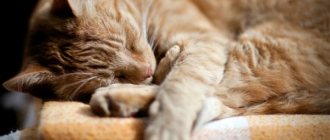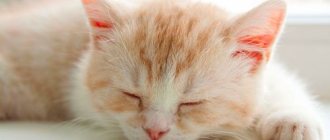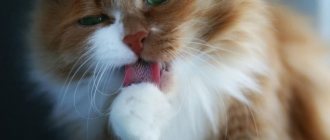If a cat falls from a height and lands unsuccessfully, then injury and bruise cannot be avoided. Of course, the health of the animal is not threatened by jumping from a cabinet, table, bed or tree. But if a cat fell out of a window from the fifth floor or even from the third, there is a high probability of fractures, concussion, and damage to internal organs. Therefore, if a cat accidentally falls from a great height and has characteristic signs of damage, it is necessary to urgently take the pet to the veterinary clinic.
Consequences
Cats love to climb tall trees, fearlessly climb onto roofs, and sometimes they have the desire to jump out of a window, and not from the first, but preferably the third or sixth floor. The animal deftly lands on its paws and never falls on its back. However, sometimes such falls end in disaster for the pet. If a cat crashes and severely damages its limbs, spine or internal organs, there is little chance of a successful recovery. Therefore, it is important for the owner to monitor the safety of the pet, especially if he lives in a high-rise building on the top floors.
Fractures and bruises
A cat falling from a height is rarely accompanied by any consequences. The animal's body is designed to jump from incredible heights.
A possible outcome in such a situation is a fracture of the spine, in which the animal does not move.
If cats jump from a window 3-5 stories high, and the surface on which they land is not concrete, the danger of breaking is minimal. But when the cat falls out from 6-7 floors, the likelihood of getting injured or bruised increases. If a cat falls from a window located at a high altitude, a fracture of the spine and limbs may occur. The symptoms in this case are:
- complete immobility;
- unnatural position of the back limbs;
- severe pain shock, lack of response to stimuli.
Bleeding and bruising of internal organs
If a cat falls out of a window from the 8th-9th floor, there is a high probability of damage to the animal’s organs. A characteristic sign of internal bruises and tissue rupture is bleeding from the nose or anus, a sharp increase in the volume of the abdomen, severe pain on palpation. To prevent the injured cat from dying, it is necessary to urgently take it to the hospital, because in such situations it will not be possible to help the animal on your own.
Brain concussion
One sign of brain damage in your pet may be a difference in the size of its pupils.
A fall from a height can result in damage to the skull and a concussion. In this case, the animals experience severe vomiting, breathing problems, they do not understand where they are, do not recognize the owner, and they sway greatly when walking. Other symptoms of brain damage include:
- hematomas, bruises and bruises in the head and neck;
- redness or pallor of the mucous membrane;
- different pupil sizes;
- rapid movement of the eyeballs;
- lack of response to light stimulus;
- convulsions;
- increase in heart rate.
What are the symptoms of serious injury after a fall?
A visual inspection will tell you what injuries the cat received when it fell:
- if she lies motionless, most likely she has a spinal fracture;
- failure of the hind legs indicates damage to the pelvic bones;
- curvature of the limbs and lameness will indicate dislocations or fractures;
- vomiting and disorientation may suggest a concussion;
- heavy breathing will reveal a lung bruise;
- drooling and an open mouth are signs of a jaw fracture;
- an enlarged, painful abdomen combined with bleeding from the nose, mouth or anus indicates serious injury to internal organs;
- shallow breathing, pale mucous membranes, weak pulse suggest traumatic shock;
- blood in the urine will indicate a kidney injury.
If no visible damage is found, do not rush to relax. Alarming symptoms may appear later. Among them:
- drowsiness;
- aggression;
- decreased appetite;
- spitting out food;
- increased salivation;
- breathing problems due to diaphragmatic hernia;
- unsteady gait;
- reluctance to step on paws;
- forced poses;
- lack of urination (more than a day) and defecation (more than two days).
Once I saw a neighbor's cat fall from a 5th floor window. She landed, was in a stupor for several seconds, and then flew away in an unknown direction. This behavior does not at all mean that the animal remained safe and sound. The release of adrenaline into the blood from the resulting stress could temporarily dull the pain, and serious consequences would appear a little later. Unfortunately, nothing is known about the further fate of this cat.
If a cat falls, it can suffer internal injuries that are invisible to the eye, so in any case it is important to show it to a qualified veterinarian.
How to provide first aid?
If a cat has disappeared from your apartment, you will most likely be able to find it on the street. You need to carefully look for the animal under a tree or bush, because often after an injury the cat tries to crawl away and hide. If the cat does fall from the balcony and there are all signs of damage, it is important to provide him with first aid:
An animal that has been seriously injured should not be handled.
- If damage to the spine or skull is suspected, it is prohibited to pick up the animal or try to move it. This will cause even more damage and unbearable pain.
- If a cat falls from the windowsill and loses consciousness, do not bother him. It is necessary to check the respiratory function, and if it is absent, try to perform artificial respiration.
- If a concussion occurs, your pet may vomit violently. If the cat does not get up on its own, you should raise its head so that the vomit does not enter the respiratory system.
- If a cat has damaged internal organs after a fall, it is important to immobilize it. To relieve pain, it is recommended to apply a cold compress to the stomach and head.
- If the injury is serious, the animal will not eat or drink water. You should not force him to take food by force; at this moment the body does not need food.
If an animal behaves normally after falling from a height, but is limping or has trouble sleeping, it is better to observe it for one or two days. Often cats do not immediately show that they feel bad. However, symptoms soon appear and if treatment is not timely, severe complications and consequences develop, which are then much more difficult to deal with. Therefore, it is recommended to periodically show pets that often jump and fall from heights to the veterinarian.
What to do in case of drowning?
The injured animal should be wrapped in a towel to keep it warm.
If a cat falls into the water, it is important to urgently remove the fluid in the lungs, trachea, and nose.
To do this, you need to press on the chest 3-4 times, after laying the cat on its side. If there is no heartbeat, an urgent cardiac massage is needed, sometimes it is necessary to hit the chest for the muscle to start working. If the cat has regained consciousness, it is important to warm it up by wrapping it in a towel and laying it on the bed near the radiator. When the animal comes to its senses, it is better to take it to a veterinarian, who will tell you what to do next.
How to prevent a cat from falling out of a window
Cats love heights, so they don't feel much fear. The result is often falls and serious injuries. It is possible to protect an animal from such a situation by following safety rules:
The safety of the animal depends on the owner
- If the animal likes to sit on the windowsill, then it is recommended to take care of durable mosquito nets that can withstand serious pressure.
- Nets should also be placed on the balcony to prevent the possibility of falling from it.
- When leaving the apartment, be sure to check all the windows; in the absence of the owner, cats become even more curious.
- If your pet experiences falls from the bed, cabinets, or other places while sleeping, you should contact your veterinarian for an examination. Perhaps this is a sign of some disease.
If a cat falls from a height, then in most cases the fault lies with the owner. Inattention and absent-mindedness lead to similar consequences. The injured animal is carefully and quickly taken to the hospital for diagnosis and selection of the most appropriate treatment. Following preventive measures will help avoid accidents.
Diagnosis and treatment
If a falling cat was unable to land on its feet and was seriously injured, it is necessary to urgently take it to a veterinary clinic. During the initial examination, the doctor will understand whether the animal can stand and move independently. If all the symptoms of a fracture of the spine or limbs are present, radiography is prescribed. If a concussion is suspected, an MRI is performed. If the cat does not go to the toilet for a long time, an additional ultrasound of the bladder is prescribed, since internal organs are often damaged when falling.
After confirming the diagnosis and determining the extent of damage, treatment is prescribed. If it is possible to find fractures, a plaster cast or a fixing bandage is applied. It is important to ensure that the animal moves less. For a concussion, the following groups of drugs are prescribed:
Depending on the diagnosis, certain medications are selected for the animal.
- painkillers;
- sedatives;
- normalizing cerebral circulation and pressure;
- antiemetics.
If the cat has become nervous, does not recognize the owner and is constantly trying to jump off the hands, additional consultation with a neurologist will be required. To suppress nervousness and aggression, a long course of potent sedatives is prescribed. Antibiotics may be prescribed to prevent inflammation at the site of injury. Sometimes it happens that after a fall from a great height, the animal does not pee and cannot go to the toilet for the most part. In this case, in addition to drug treatment, abdominal massage is prescribed. For successful recovery, it is important to provide your pet with physical and emotional peace.
What happens when you hit your head?
When an animal experiences a concussion, the functioning of the central nervous system and musculoskeletal system is disrupted for some time. Most often, cats suffer from mild concussions.
As you know, a strong concussion in a cat is the result of damage due to an impact. If proper treatment of a brain injury is not started in time, this is fraught with complications that can develop into chronic diseases that can worsen the pet’s health and limit its physical activity.
Every cat owner should be clearly aware that even a minor injury to the head can result in a concussion. Moreover, the more minor the damage, the more difficult it is to determine disorders in brain activity at home.
The cat may behave absolutely adequately, not suffer from a lack of appetite, and also not show signs of impaired motor functions. However, after some time, symptoms such as seizures, heart problems, and behavioral disorders may suddenly appear. This indicates a hidden brain injury.
Therefore, there is no need to wait for any symptoms of a concussion to appear after the impact - you need to take your pet to the veterinarian. Moreover, for emergencies there is a 24-hour veterinary clinic. It is better for this to be a false alarm than for the appearance of chronic diseases as a result of delayed treatment or lack of treatment at all.
Prevention: what to do?
Valeria Oleinik, a veterinarian at the 911 clinic, advises closely monitoring the safety of cats, which often like to climb to heights and jump from there. Therefore, before leaving for work, do not forget to check all windows and balcony doors; for greater safety, it is recommended to install window protective nets. If a cat dies after falling from a great height, the owner does not need to blame himself, although it is not easy to survive such a loss. It is important to draw the right conclusions from the current situation and try to eliminate the factors that caused the tragedy.
Strange animal behavior
You should promptly consult a specialist if your cat exhibits the following signs:
- Uneven pupils.
- Lack of pupillary response to light stimulus.
- Rapid and unnatural eye movements.
- A cloudy spot on the pupil, trembling of the iris, an abnormal appearance of the eye associated with displacement of the lens or damage to the ligaments that support it.
- Bruising on the head.
- Too pale or, conversely, too reddened mucous membranes.
- Dizziness (its sign is an unsteady and unsteady gait).
- Headache is a sign of it: the animal rests its head on a hard surface and stands motionless.
- Drowsiness.
- Attacks of aggression.
- Involuntary twitching of paws and facial muscles.
- Paralysis of limbs.
- Short-term loss of hearing or vision.
- Difficulty in orientation.
- Increased heart rate.
- Intermittent breathing accompanied by wheezing.
You need to know that the intensity of the symptoms of a concussion in a cat directly depends on the severity of the injury and the area affected. The mechanism of brain damage during trauma is as follows: the place where the blow was directly received suffers, and after that the brain hits the opposite wall of the skull, also receiving injury. During a concussion, the hypothalamus and brain stem are most vulnerable. Brain hemorrhage is very dangerous. This condition can lead to paralysis of the animal, temporary or permanent, so it is very important to get help as soon as possible. Typically, the main symptoms in animals disappear within 2 weeks. In any case, calling a veterinarian will not hurt.
Providing first aid for a concussion in a pet
If the cat received a blow to the head area and there is a suspicion that she has a concussion, then you need to bring her into a room with dim lights and put her down. If the symptoms do not disappear within ten minutes, then you should definitely seek advice from a specialist. Large cities usually have a 24-hour veterinary clinic.
In case of loss of consciousness, you must follow the following algorithm:
- do not try to stir up the animal or lay it on its side;
- in case of tongue retraction, ensure its straightening;
- Apply dry cold to the injury site;
- make a cold compress on the head (wet a towel in cold water, fold it several times and place it on the animal’s head);
- if there is an open wound, you need to stop the bleeding and apply a bandage;
- if vomiting begins, make sure that the cat does not choke on the mass;
- in case of cessation of breathing, it is recommended to perform indirect cardiac massage and artificial respiration.
Among the drugs that can be used without consulting a doctor, use an injection of caffeine and camphor. But it’s better not to treat a cat’s concussion on your own. The symptoms should prompt you to see a specialist.
